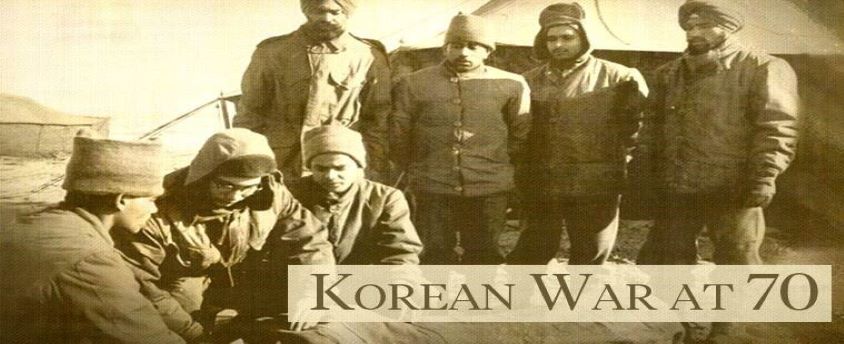India and the Korean War
01, Apr 2023

Prelims level : International Relations
Mains level : GS-II Effect of policies and politics of developed and developing countries on India’s interests, Indian diaspora.
Why in News?
- In its G20 year, India has shown renewed interest in the only other diplomatic intervention by India in a distant war (apart from the recent Russian-Ukraine) seven decades ago – The Korean War.
Origin of Divide in Korean Peninsula:
- The present-day conflict between the US and North Korea can be traced from the Cold War between the USSR and US.
- After the defeat of Japan in World War II, the Allied forces at the Yalta Conference (1945), agreed to establish a “four-power trusteeship over Korea”.
- The fear of the spread of communism (state ownership over economic resources of a country) and the mutual distrust between the USSR and the US led to the failure of the trusteeship plan.
- Before a concrete plan could be formulated, the USSR invaded Korea.
- This led to a condition where the north of Korea was under the USSR and the south under the rest of the allies, mainly the US.
- The Korean peninsula was divided into two regions by the 38th parallel.
- In 1948 the United Nations proposed free elections across all of Korea.
- The USSR rejected this plan and the northern part was declared as Democratic People’s Republic of Korea (North Korea).
- The election took place in the American protectorate resulting in the establishment of the Republic of Korea (South Korea).
- Both North Korea and South Korea tried to enhance their reach, territorially and ideologically, which gave birth to the Korean Conflict.
About the Korean War:
- On 25th June 1950, North Korea, backed by the USSR, launched an attack on South Korea and occupied most of the country.
- In response, the United Nations force led by the US retaliated.
- In 1951 the US forces led by Douglas MacArthur crossed the 38th parallel and triggered the entry of China in support of North Korea.
- To prevent further escalation, peace talks began later in 1951.
- India was actively involved in negotiating peace in the Korean peninsula by engaging all the major stakeholders – US, USSR and China.
- In 1952, the Indian resolution on Korea was adopted at the United Nations (UN).
- On 27th July 1953, the Korean Armistice Agreement was signed between the UN Command, the Korean People’s Army and the Chinese People’s Volunteer Army. It led to an official ceasefire without a Peace treaty. Thus, the war officially never ended.
- This also led to the establishment of the Korean Demilitarised Zone (DMZ) – a strip of land running across the Korean Peninsula to serve as a buffer zone between North Korea and South Korea.
- In December 1991, North and South Korea signed a pact agreeing to refrain from aggression.
About the US-North Korea Conflict:
- During the Cold War era, (allegedly with the support of Russia and China) North Korea accelerated its nuclear programme and developed nuclear capabilities.
- During the same time, the US extended its Nuclear Umbrella (guarantee of support during a nuclear attack) to its allies i.e South Korea and Japan.
- North Korea withdrew from the Non-Proliferation Treaty (NPT) in 2003 and afterwards, under present leader Kim Jong-un, it increased nuclear missile testing.
- North Korea is barred from testing ballistic missiles and nuclear weapons under international law.
- In response to this, the US started deploying THAAD (Terminal High Altitude Area Defence) in South Korea in March 2017.
- The territorial conflict which started between North and South Korea has transformed into a tussle between the US and North Korea.
- Following the failure of diplomatic efforts to improve relations with North Korea, the US has imposed sanctions.
India’s lesser-known role in the war:
- India played a unique role, having no specific geo-political interests in the Korean Peninsula and maintaining a neutral position, and believing in the reunification of the peninsula.India’s view at this time was that giving the People’s Republic of China admission into the UNSC could provide a resolution in Korea.
- India made a huge diplomatic push to prevent an escalation into another world war, and for the parties to arrive at a quick ceasefire.
- India sent the 60th Parachute Field Ambulance, which did outstanding work treating wounded soldiers.
India at the UN:
- At the time of the invasion, India was among the six non-permanent members of the UNSC.
- During its rotating presidency, 3 resolutions (moved by the US) on the war came up in quick succession. For example, calling for a withdrawal of North troops from South territory, etc.
- The urgent problem of what to do with the prisoners of war was given to K. Krishna Menon – India’s Permanent Representative to the UN and a member of the UN’s Special Political Committee.
- A Neutral Nations Repatriation Committee was set up and India was selected to chair the committee.






